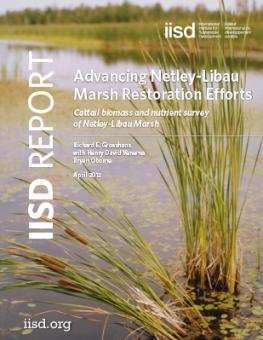
Advancing Netley-Libau Marsh Restoration Efforts: Cattail biomass and nutrient survey of Netley-Libau Marsh
Lake Winnipeg is one of the largest freshwater lakes in the world and drains a watershed area of 1,000,000 square kilometres. Overloading of phosphorus in the lake has caused an increase in the frequency of algal blooms.
The Red River contributes almost 60 per cent of the phosphorus entering the lake. Netley-Libau Marsh is the largest coastal wetland on Lake Winnipeg, comprised of shallow lakes, channels and wetland areas through which the Red River flows on its way to the lake. Over the past several decades, environmental goods and services (EGS) benefits from Netley-Libau Marsh have been compromised by drainage, dredging, and water management. The result has been a gradual loss of plant communities, erosion of channels and islands, amalgamation of water bodies, and subsequent decline in wildlife habitat and populations. Netley-Libau Marsh is not currently functioning as a healthy coastal wetland, and many benefits to Lake Winnipeg that the marsh could provide have been severely degraded. Restoration and management of this important coastal wetland could help restore degraded environmental benefits.
The purpose of this study was to improve our understanding of how this freshwater coastal wetland—and wetlands throughout the watershed—reduce nutrient loading and ultimately improve water quality in Lake Winnipeg. Emergent plants play a critical role in physical marsh structure and in water-quality improvement. A healthy marsh plant community captures and stores nitrogen and phosphorus in the sediment, litter, roots and accumulated biomass. Cattail (Typha spp.) is one of the dominant plant species in Netley-Libau Marsh.
New site research was conducted in August and September of 2009, collecting samples and survey information throughout Netley-Libau Marsh. Samples were collected of plants, roots, litter, and sediment as well as water, and analyzed for a suite of elements and parameters.
Total phosphorus (TP) is the total amount of inorganic and organic P that is found in the water. Manitoba Water Quality Guidelines state TP should not exceed 0.025 mg/L in water bodies. Average TP concentrations in Netley-Libau Marsh during August 2009 ranged between 0.39 and 3.53 mg/L, significantly above the guideline.
Total stored phosphorus and nitrogen is estimated to be 525 tonnes and 1,965 tonnes in the plants (plants, roots, and litter) and 230 and 305 tonnes in sediment respectively. Restoration of the cattail and other marsh plants by 25 per cent could increase phosphorus and nitrogen storage potential in the marsh by 130 and 500 tonnes respectively.
Participating experts
You might also be interested in
Large Area Planning in the Nelson-Churchill River Basin (NCRB): Laying a foundation in northern Manitoba
This report explores two trends—the growing tendency towards large basin management and consideration of ecosystem services in decision making—for the northern portion of the Nelson-Churchill River Basin in Canada.
Large Area Planning in the Nelson-Churchill River Basin (NCRB): Laying a foundation in northern Manitoba (Summary)
This document summarizes a longer report that explores two trends—the growing tendency towards large basin management and consideration of ecosystem services in decision making—for the northern portion of the Nelson-Churchill River Basin in Canada.